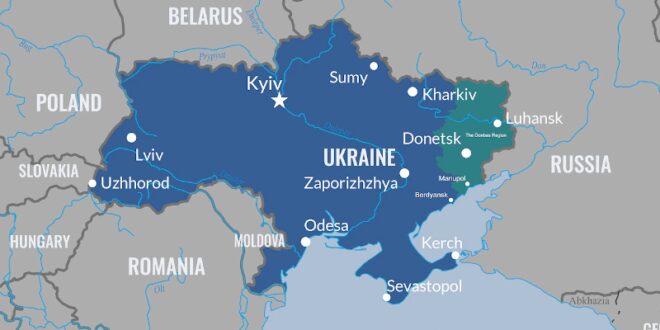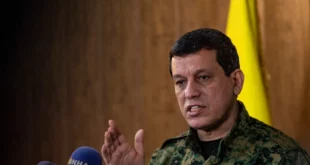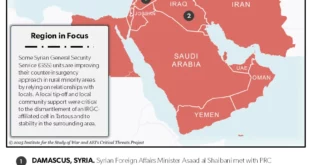After thirteen months since the outbreak of the Russia-Ukraine warfare, neither country will likely be able to achieve absolute victory[2], while confronting the daunting possibility of war protraction. Thus, now is high time to identify its root cause in search for an end to the warfare.
True, Russian’s aggression against Ukraine is evident, but it is a result, rather than a cause, of the circumstances, as in the common saying “there is no smoke without fire”. Given that Ukraine neither made an armed attack nor deliberated an imminent attack against Russia, its armed invasion seems to constitute a quintessential case of one nation-state’s unprovoked aggression against another according to basic international law. Yet, Russian President Vladimir Putin has justified the invasion by invoking “the responsibility to protect”, another international law principle. It is often applied to an ethnic conflict in an independent state that involves mass atrocity crimes, such as genocide, war crimes, ethnic cleansing, and crimes against humanity, allowing another state (or states) to militarily intervene for stopping these acts in the name of international community. Putin has claimed that the invasion forces are carrying a special military operation aimed to demilitarize and de-Nazifying Ukraine and to stop Ukraine’s armed forces from committing mass atrocities in the Donbas[3]. Now that Russia has recognized the independence of two former Donbas oblasts[4] and concluded security treaties with them, the legal status of the armed conflict has arguably been changed from an internal to an inter-state one. After that, Putin may also justify an intervention by invoking the right of collective self-defense under Article 51 of the U.N. Charter.
Now, it is becoming more essential than ever to grasp the context and circumstances of the Russian invasion in search of a settlement through diplomatic negotiation. This is because the evolving situation on battlefield seems to exclude the possibility of an early military solution of the armed conflict, given that it will surely be protracted due to the unflinching war efforts of Russia and Ukraine and to the sizable military assistance and economic sanctions of the U.S.-led West that support Ukraine. Yet, neither Western governments nor the mainstream mass media have provided adequate background information and analysis on which to judge Putin’s claim and the justifiability of the invasion, while treating the invasion as a bolt from the blue. To fill in the gap, therefore, this study will inquire some crucial facts that have been missed or de-emphasized in the current mainstream discourse on the warfare in Ukraine.
1. Ukraine’s offensives against Donbas preceded
The start of Russia’s aggression against Ukraine on February 24 last year was not at all a bolt from the blue, given that, for several days since February 16, Ukraine’s armed forces had sharply intensified artillery shelling against the Russian-speaking Donbas region, as indicated by Daily Reports of the Special Monitoring Mission to Ukraine of the Organization of Security and Cooperation in Europe (OSCE)[5]. Evidently, this is an outright violation of the Minsk Protocol II of February 2015, a cease-fire agreement between the Ukrainian government and the Donbas separatist authorities that reflects the preceding negotiation among the then-top Ukrainian, Russian, Donbas, French, and German leaders. Apparently, Kiev made a politico-strategic decision for the offensive, in marked contrast to minor violations of tactical nature on frontline, such as skirmishes, that both sides had sporadically committed without such a decision. There is little wonder that the offensive gave Putin a good pretext to venture an “special military operation”, at least against the region[6].
Notably, the Ukraine’s military had planned the offensive well beforehand, given the necessity of munitions and other logistical stockpiles near the designated area of offensive operations. More specifically, in March 2021, Ukrainian President Volodymyr Zelensky submitted the draft law on indigenous peoples of Ukraine to the National Legislature (Rada)[7], which was adopted in early July of the year[8]. Based on the law, the President authorized the “strategy for the de-occupation and reintegration of the temporarily occupied territory of the Autonomous Republic of Crimea and the City of Sevastopol”[9] and issued a decree for the recapture of the Crimea (No. 117/2021)[10], involving a sizable deployment of Ukraine’s armed forces to the southern areas of the country bordering with the Donbas.
Of course, this move by Zelensky did not transpire in vacuum, but out of the context of the protracted warfare in Donbas for eight years since Russia’s annexation of Crimea in 2014, as indicated by the OSCE Special Monitoring Mission to Ukraine that existed from March 21, 2014 to March 31, 2022.
2. The Ethnic Conflict in Donbas
The regional warfare in Donbas was consequent on intensification and expansion of the armed ethnic conflict between the Ukrainian government in Kiev and the Russian-speaking separatists across the country, especially in the Donbas where the Russian-speaking residents occupy a significant majority of the total local population. In 2014, there were a series of mass protest demonstrations and riots in the Russian-speaking regions (Odessa, Dnepropetrovsk, Kharkov, Lugansk, and Donetsk), against the central government. The government used its security forces to repress the riots, while volunteer militia were actively engaged in atrocities against the Russian-speaking population[11].
The conspicuous destabilization of domestic security was brought about by a major shift in cultural and language policy of the Ukrainian government against the vital interests of the Russian-speaking population. In February 2014, the Ukrainian government abolished the Kivalov-Kolensnichenko Language Law of 2012 that granted the Russian language the status of a regionally official language[12], several days after the anti-riot laws restricting the freedom of speech and that of assembly were passed[13]. The move is against the rule of thumb to manage an ethnic problem by granting full autonomy and self-government, especially in cultural and language policy, to a minority population within the framework of the sovereign state concerned, as demonstrated by the classical case of Italy’s South Tyrol Autonomous Province.[14]. Naturally, Russia saw the move aggressive against the “Russian-speaking population” in Ukraine[15]. With Russia’s understanding, therefore, the Russian-speaking population in Donbas dared to organized itself for protest demonstration, autonomy, and self-government, involving the strong potential to develop into independence movement unless its demands were adequately accepted.
3. U.S.-led West’s subversion and proxy war
The Maidan Revolution of 2014 necessitated the Ukrainian government to shift from its longtime pro-Russian to a pro-Western external orientation, and also marked a turning point toward protracted ethnic conflict in Donbas. These two seemingly separate phenomena are in fact the head and tail of the Donbas ethnic question because the region is a legal territory of Ukraine and an integral part of the arguably historical Novorossiya of the Russian Empire[16], in which the Russian-speaking residents constitute a significant majority of the region’s total population. Yet, the ethnic volatility there was only latent because the Ukrainian Soviet Socialist Republic existed as a constituent republic of the Soviet Union, with little substantive political independence and power under a one-party system ruled by the Communist Party of Ukraine, a branch of the Communist Party of Soviet Union[17]. Thus, the Republic’s secession from the Union was unrealistic and practically infeasible until the debilitation and demise of the Union under Mikhail Gorbachev, despite the constitutional right to secede.
The birth of a pro-West Ukrainian government after the Revolution has met U.S. hegemonic interests well because Russia will not be able to come back as a primary great power without Ukraine that possesses geopolitical, population, and economic significance[18]. In fact, the Barack Obama administration intervened extensively and deeply in Ukrainian domestic politics of constitutional revision toward NATO accession in which then-Vice President Joe Biden played a primary role[19].
Also, to help Kiev throw its militia against Donbas separatist armed forces, the U.S. as well as the U.K, Canada, France, Germany, and Poland, financed to form the Centuria Project to arm and train some 100,000 soldiers, with strong ties to Ukraine’s far-right Azov movement[20]. (The U.S. Congress enacted a legislative measure, Consolidated Appropriation Bill of 2018, to ban military aids to the Azov paramilitary due to its white supremacist ideology and neo-Nazism[21]) With the Cold War over, the Donbas issue merely constituted a potentially volatile ethnic question. Since its metamorphosis into a domestic armed conflict, it had become an intrinsically “civil war” within Ukraine. But it did not matter to the U.S.-led West without any vital security interests involved, although the contrary was the case for Russia. Nonetheless, the U.S.-led West had intervened there with persistent acts of anti-Russia subversion and proxy warfare, bringing Russia to bay to eventually commit the act of unprovoked aggression against Ukraine. It is natural that Russia fiercely resisted the U.S.-led West.
Now that the West has imposed maximal economic sanctions short of direct military intervention while extending various military and financial assistance to Ukraine, Russia is intensely challenging the U.S.-led international order. The U.S.-Russia confrontation has fallen into a stalemate because the U.S. economic-financial hegemony greatly relies on the manufacturing power and supplies of natural resources and materials from the BRICS and the developing world, while they are not sided with the U.S.-led economic sanction against Russia. The negative spiral of the confrontation has dramatically raised U.S. stakes, unnecessarily transforming the confrontation into a grave continental-European security problem and now an increasingly global geostrategic and geoeconomic one.
4.Needed: a realpolitik approach to political settlement, not war propaganda
Hitherto, this inquiry has examined, reversely over time, major features of the backgrounds through which the warfare in Ukraine had evolved out, with a focus on the U.S.-led political and military intervention in Ukraine, and the Donbas in particular. The analysis has found that, in the prelude to the warfare, the U.S.-led West had successfully engineered continual subversion and prolonged proxy war against Donbas separatist armed forces and the authorities, while having cornered Russia politico-strategically.
The above U.S.-led intervention to Ukraine is nothing more than a commonplace affair in anarchical international politics. A strong state is assumed to maneuver aggrandizing its power and/or weakening its opponent. Some of maneuvers are legitimate under international law, some in gray zone, and others illegitimate though great powers often employ dirty hands to one another.
With war propaganda increasingly intensified, however, the dominant Western international media has consistently deemphasized and often ignored the above realpolitik background, instead emphasized Russia’s outright violation of international law regarding the unprovoked aggression against Ukraine and alleged acts of unspeakable atrocity. On the other hand, Russia counterpropaganda has been comparatively limited and less effective. It is unknown if this is because Russia is less capable of war propaganda or because Russia calculates that such propaganda will lead the West to a protracted warfare in Ukraine, which may harm the West and benefit Russia[22].
Given that neither Ukraine nor Russia is able to achieve absolute victory in a foreseeable future, and that war protraction will not necessarily benefit the U.S.-led West[23], it is imperative to put an end to the warfare through diplomatic negotiation, hopefully a political settlement or at least an armistice. Evidently, now is high time for Ukraine, Russia, and the U.S.-led West to get emancipated from war propaganda and squarely face the realpolitik background as can be found over the prelude period to the warfare in Ukraine (2014-2022), involving a cool-headed geostrategic deal between the U.S. and Russia.
 Eurasia Press & News
Eurasia Press & News



